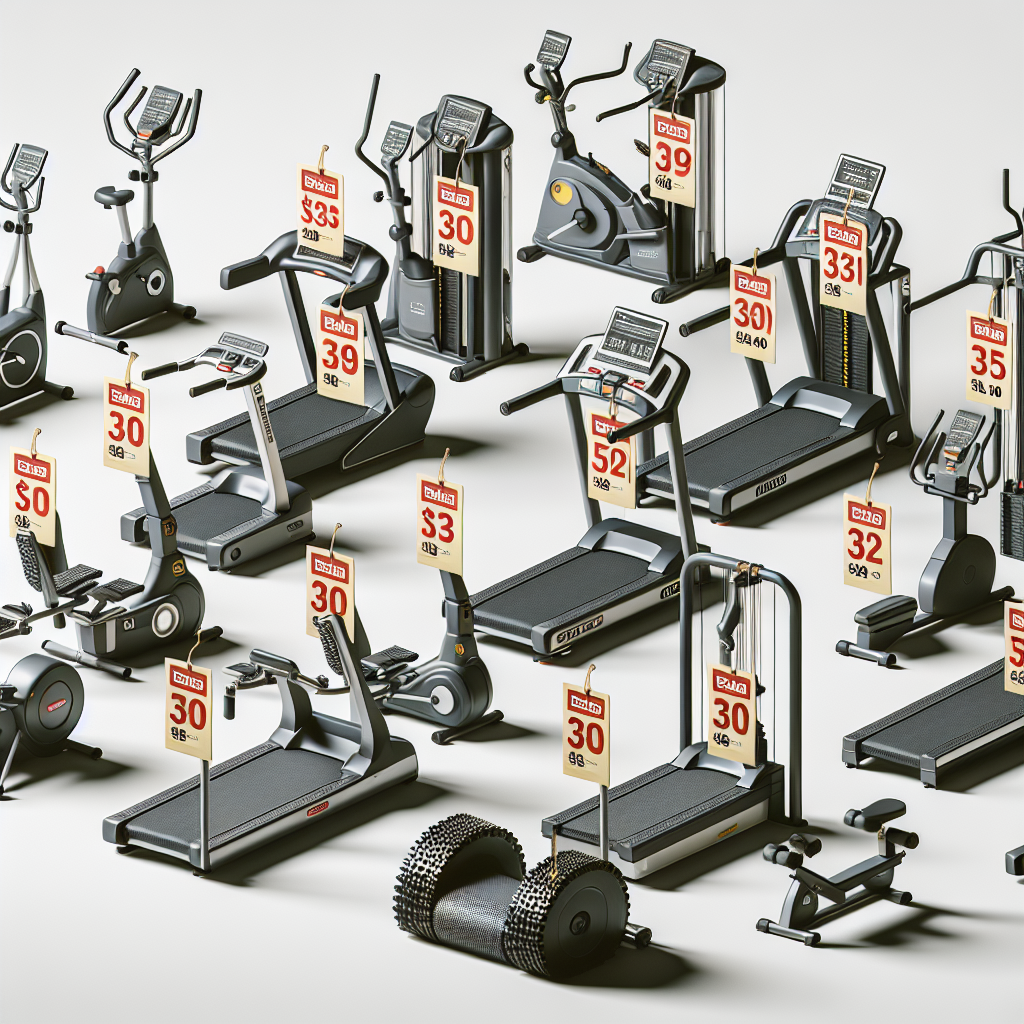In the increasingly fitness-conscious world, the demand for gym machines has seen a considerable rise. As someone deeply invested in the realm of physical exercise and with a keen interest in understanding the financial considerations surrounding gym machines, I sought to compare and analyze their costs. By delving into the realm of moderne gym machines, I will scrutinize their prices, draw comparisons, and provide a succinct summary of each, ultimately shedding light on the most cost-effective options for those seeking to enhance their gym machine workout plan.
Comparing and Analyzing Gym Machine Costs

Overview of Gym Machines
Gym machines are crucial components of fitness training in both commercial and residential settings. They offer individuals the opportunity to engage in a wide variety of exercises that target different muscle groups and improve overall strength and cardiovascular fitness. Gym machines come in various types, including cardio machines, strength training machines, and multi-functional machines, each designed to serve specific fitness goals.
Factors Affecting Gym Machine Costs
Several factors influence the costs of gym machines. One significant factor is the brand and manufacturer. Well-established brands with a reputation for quality and durability often charge higher prices for their machines. Additionally, the features and specifications of a machine also contribute to its cost. Machines with advanced technology, customizable settings, and user-friendly interfaces may be more expensive than basic models.
The size and weight of gym machines can also impact their costs. Larger and heavier machines require more material and more complex manufacturing processes, thus increasing their price. Maintenance and servicing requirements are another factor influencing costs. Machines that need regular maintenance or expensive repairs may have higher initial costs compared to low-maintenance machines.
Lastly, market demand and accessibility also affect gym machine costs. Machines that are in high demand and have limited availability may be priced higher due to their popularity and scarcity.

Types of Gym Machines
Gym machines can be categorized into three main types based on their primary function: cardio machines, strength training machines, and multi-functional machines.
Cardio machines are designed to elevate heart rate and improve cardiovascular endurance. They include treadmills, stationary bikes, elliptical trainers, and rowing machines. These machines provide low-impact options for individuals looking to burn calories, improve stamina, and enhance cardiovascular health.
Strength training machines, on the other hand, focus on building and toning muscles. They typically target specific muscle groups and provide resistance to facilitate muscle growth. Examples of strength training machines include dumbbell sets, barbell sets, and weight benches.
Multi-functional machines combine elements of both cardio and strength training machines. These versatile machines offer a wide range of exercises that target multiple muscle groups, making them ideal for individuals seeking a comprehensive workout.
Cost Range for Different Gym Machines
Gym machines come in varying price ranges depending on their type and specific features. Treadmills, which are popular cardio machines, typically range from $500 for basic models to over $3,000 for high-end treadmills with advanced features such as incline settings and built-in workout programs.
Stationary bikes are another common cardio machine and can range from $200 for basic models to $2,000 or more for bikes with features like built-in screens, adjustable resistance levels, and integrated workout programs.
Elliptical trainers, known for their low-impact yet intense workouts, can range from $500 to over $2,500. Rowing machines, which provide a full-body workout, generally range from $200 to $1,500.
Strength training machines vary in cost depending on the type and complexity of the equipment. Dumbbell sets can range from $100 for a basic set to over $500 for a set with adjustable weights. Barbell sets, which include not only the barbell but also weight plates, can range from $200 to $1,000 or more.
Weight benches, used for various strength training exercises, range from $100 for a basic bench to $500 or more for benches with added features such as adjustable incline settings and leg extensions.
Multi-gym systems, which offer multiple exercise options, can range from $500 for compact home models to over $5,000 for commercial-grade machines.

Cost-Effectiveness of Gym Machines
When considering the costs of gym machines, it is essential to evaluate their cost-effectiveness. The frequency of use is a crucial factor to consider. If a gym machine will be used frequently, investing in a higher-priced, durable machine may provide better value in the long run. On the other hand, if a machine will only be used occasionally, a more budget-friendly option may be appropriate.
Investing in gym machines also represents a long-term investment in health and fitness. By having access to gym machines at home, individuals can save money on gym memberships and have the convenience of working out at any time. Comparing the long-term costs of a gym membership versus purchasing gym machines tailored to one’s fitness goals can help determine the cost-effectiveness of owning gym machines.
Comparing Costs of Cardio Machines
Treadmills, stationary bikes, elliptical trainers, and rowing machines are popular choices for cardiovascular workouts. When comparing costs, it is essential to consider the specific features and benefits of each machine.
Treadmills typically have the highest cost range among cardio machines due to their versatility and popularity. They provide an efficient way to burn calories, simulate outdoor running, and offer various workout programs. Stationary bikes are generally more budget-friendly compared to treadmills, making them a popular choice for individuals seeking a low-impact cardiovascular workout.
Elliptical trainers offer a combination of lower and upper body movements, providing a full-body workout that minimizes joint impact. They fall within a similar price range as stationary bikes but offer greater muscular engagement.
Rowing machines, gaining popularity for their ability to engage the entire body, are often more affordable than treadmills and elliptical trainers but still provide an effective cardiovascular workout.

Analyzing Costs of Strength Training Machines
Strength training machines, such as dumbbell sets, barbell sets, weight benches, and multi-gym systems, offer individuals the opportunity to build and tone muscles. When comparing costs, it is crucial to consider the specific benefits and versatility of each machine.
Dumbbell sets generally have a lower price range compared to barbell sets but are more versatile in terms of exercise options. Dumbbells allow individuals to target specific muscle groups and perform a wide range of exercises. Barbell sets, on the other hand, provide greater stability and allow for heavier lifting, making them ideal for individuals focusing on strength training.
Weight benches are essential for performing various strength training exercises, such as bench presses and chest flyes. Basic weight benches are generally more affordable, but adjustable weight benches with added features offer increased versatility and customization options.
Multi-gym systems are the most expensive among strength training machines due to their versatility and comprehensive workout options. These machines typically include various stations for different exercises, allowing users to target multiple muscle groups in one workout.
The Benefits of Investing in High-Quality Machines
Investing in high-quality gym machines offers several benefits. One key advantage is durability and longevity. Well-built machines with quality materials and construction are more likely to withstand daily use without experiencing significant wear and tear. This reduces the need for frequent replacements or repairs, thus saving money in the long run.
High-quality machines also prioritize safety and user experience. They are designed with ergonomic features and adjustable settings to ensure proper body alignment and minimize the risk of injuries. Additionally, these machines often come with reliable warranty options and excellent customer support, providing peace of mind to users.
Budget-Friendly Options for Gym Machines
While high-quality machines offer several advantages, there are budget-friendly options available for individuals with financial constraints. Many brands offer entry-level models that provide basic functionality at a more affordable price point. These machines may have fewer features but still serve the purpose of improving fitness and strength.
Additionally, purchasing used gym machines can significantly reduce costs. Many people sell their lightly used machines at a fraction of the original price, providing an opportunity for cost savings. However, it is crucial to ensure that used machines are in good working condition and have been properly maintained.
Considerations for Long-Term Cost Savings
To maximize long-term cost savings, it is important to consider certain factors when purchasing gym machines. Regular maintenance and servicing can prolong the lifespan of machines and prevent costly repairs. Simple tasks such as lubricating moving parts and checking for loose bolts can significantly extend the durability of the machines.
Some machines offer upgrade options or add-ons that can enhance their functionality over time. Investing in machines that have the potential for future upgrades can save money in the long run, as it eliminates the need to purchase new equipment when fitness goals evolve.
Opting for versatile and multi-purpose machines can also lead to long-term cost savings. These machines provide a wide range of exercise options, eliminating the need for multiple specialized machines. By investing in one multi-functional machine instead of several individual machines, individuals can save money and space.
Lastly, considering the resale value of gym machines is important for long-term cost savings. High-quality machines from reputable brands often retain their value well and can be sold or traded in when no longer needed. This allows individuals to recoup a portion of their initial investment and potentially upgrade to newer models without incurring significant additional costs.
In conclusion, comparing and analyzing gym machine costs is essential for making informed decisions when purchasing fitness equipment. Understanding the factors that affect gym machine costs, knowing the types of machines available, and considering the cost-effectiveness of different options are crucial steps in finding the right gym machines for individual fitness goals. By evaluating the Benefits of investing in high-quality machines, exploring budget-friendly options, and considering long-term cost-saving strategies, individuals can make smart decisions to create a well-equipped workout space tailored to their needs.



3 thoughts on “Comparing and Analyzing Gym Machine Costs”